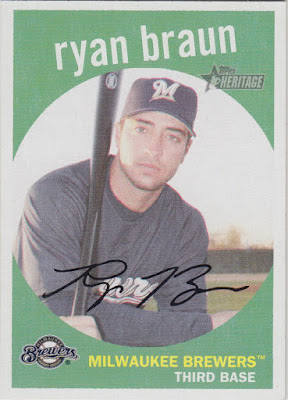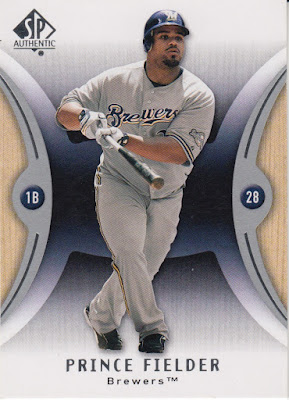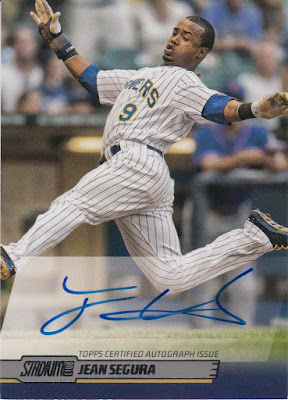Though Lauzerique was just 22 years old at the beginning of the 1970 season, it was the fourth year in a row that he saw action in the major leagues. It would also be his last season in the majors.
 |
| 1970 McDonald's Milwaukee Brewers |
Lauzerique was selected in the 10th Round of the 1965 Draft by the Kansas City Athletics. His major league career is nothing to speak of, frankly -- 113-1/3 innings, a 5.00 ERA (5.28 FIP), 1.8 HR/9, a 1.52 K/BB ratio. But when the name George Lauzerique is raised to hardcore baseball fans from the 1960s, what comes to mind for them is the incredible farm system that the Athletics had and, in particular, the 1967 Birmingham Athletics team.
As Bill James mentioned in The New Bill James Historical Baseball Abstract, A's owner Charlie O. Finley grew up in Birmingham, so he put all of the talented players in the farm system there to put on a show. The team included two future Hall of Fame players in Reggie Jackson and Rollie Fingers, a future Hall of Fame manager in second baseman Tony LaRussa, and other notables such as Joe Rudi, Marcel Lachemann, Dave Duncan, and even, in a 2-game cameo, future A's, Padres, Reds, Angels, Red Sox, Indians, and Angels (for a second go-round) manager John McNamara (who was the manager in Birmingham).
James's book notes that, despite all those luminaries, George Lauzerique was "the star of the show." The numbers speak for themselves: 13-4 record, 2.30 ERA, 168 innings, 120 hits allowed, 54 walks, 125 strikeouts, and, on July 6, 1967, a seven-inning perfect game against Evansville in which he threw just eighty-five pitches.
The eighty-five pitches is notable and was mentioned in the news story about the game because the Athletics apparently were ahead of their time in protecting young arms somewhat. The A's put Lauzerique on a pitch count of 100 to 115 pitches in an effort to force him to be more economical with his pitches and to improve his control. In his autobiography, Don Zimmer noted that playing against Lauzerique was the first time that Zim had ever seen a pitch count come into play:
My first experience with pitch counts was when I was managing the Knoxville club in the Southern League in 1967. We were playing Birmingham, a Kansas City A's farm team managed by John McNamara . . . . McNamara's pitcher that day was a Cuban right-handed curveballer named George Lauzerique, who was nineteen years old at the time. Well, the game is going along and we're into the seventh inning and Lauzerique is pitching a no-hitter. All of a sudden, I look up and Johnny Mac is walking to the mound to take him out! It turned out Lauzerique had reached his quota of 100 pitches, set down by the A's front office, and Johnny Mac had no choice but to follow orders. They put pitch counts on these pitchers to supposedly save their arms.As Zimmer mentions in his book in concluding his thoughts about Lauzerique and pitch counts, the fact was that the lowered pitch counts did not, in the end, save Lauzerique from injuries. Whether that was because the pitch count limits did not apply long enough through his career to get him through what Nate Silver and Will Carroll called "The Injury Nexus" in 2003, Lauzerique fought shoulder problems during his big-league career. When the Brewers sent Lauzerique down to Triple-A Portland at the end of May in 1970 to make way for Dave Baldwin, it was the last time Lauzerique would get a big-league per diem.
 |
| 1994 Miller Milwaukee Brewers Commemorative Set |
Once he gave up on being a pitcher, Lauzerique became a scout. I know this because of a couple of references. The first came in 1983 when Jim Henneman of the Baltimore Evening Sun asked Lauzerique to provide a baseball scouting report for a football player. You may recall that, in 1983, the Colts were still in Baltimore and owed the first-overall pick in the NFL draft. They selected Stanford QB John Elway. Elway didn't want to play for the Colts and told the Colts that. This was, according to the Mile High Report, because Colts coach Frank Kush was known to abuse his players badly during practices in college. Elway used his baseball ability as leverage to get traded to Denver and the rest, as they say, was history.
The other notable reference to Lauzerique as a scout was due to his time as the Cleveland Indians' East Coast Scout. Lauzerique lobbied against the Indians selecting an outfielder out of his own high school alma mater, George Washington High School, due to Lauzerique's concerns about the kid's workrate and the effect that a big draft bonus would have on the boy. The outfielder in question? Manny Ramirez.
These days, Lauzerique lives in Palm Beach County. He went through some terrible times in the past ten years, largely due to the death of his son Anthony due to an overdose of narcotics prescribed by a "pain clinic doctor" in Royal Palm Beach named John Christensen. That doctor got charged with two counts of murder, later reduced to manslaughter, based on his activities. According to a recent South Florida Sun-Sentinel story about another "pill mill" doctor, charges are still pending against Christensen and the trial has not yet been scheduled.
For George Lauzerique's sake, I hope that Christensen is held accountable for his actions.
Lauzerique has a total of 9 cards from his baseball career (though Trading Card Database does not list the 1970 McDonald's set. Of those, three cards show him with the Brewers. I need that elusive Mike Andersen postcard, but otherwise have the other two cards, shown above.















































